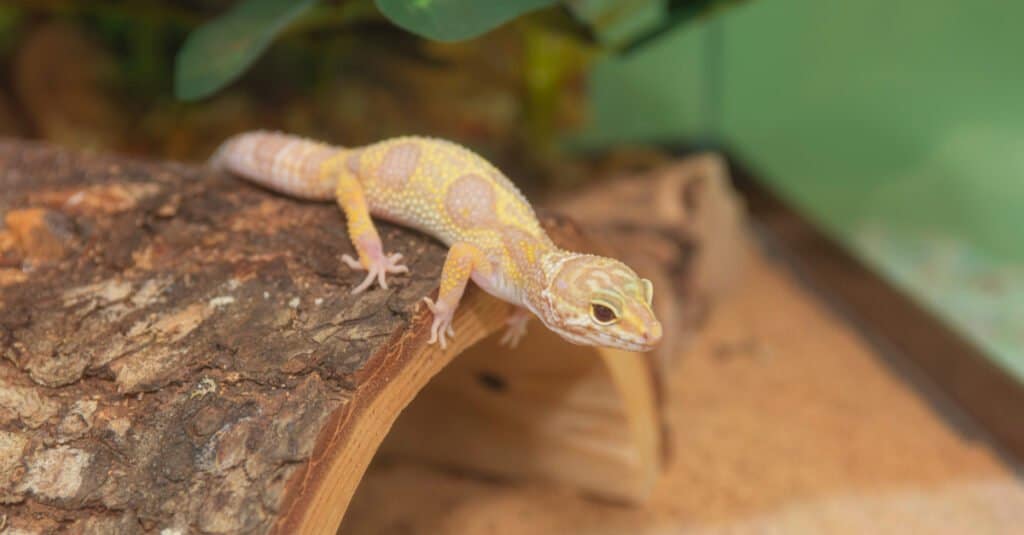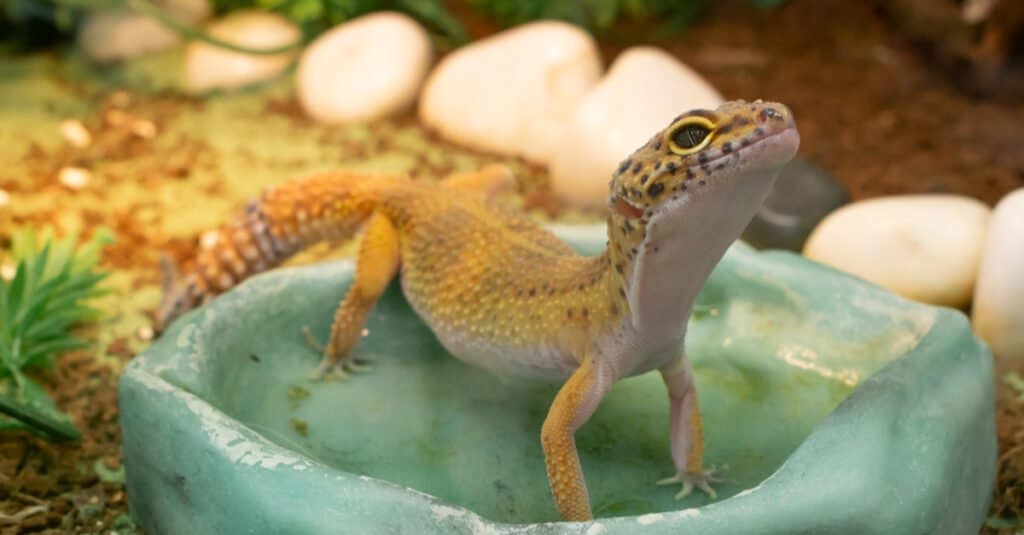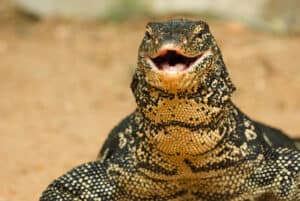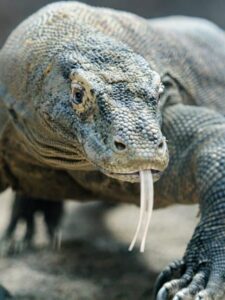Many species of lizards and geckos are surprisingly adept swimmers, but what about the ever-popular leopard gecko? Do these adorable little lizards have the right body structures and adaptations for swimming, or is it best to avoid putting them in water altogether? Below, we’ll explore whether or not leopard geckos can swim and when, if ever, a bath is appropriate for them.
Can Leopard Geckos Swim? Are They Good Swimmers?

Leopard
geckos are not natural swimmers.
©LHolmes Photography/Shutterstock.com
To get straight to the point, leopard geckos are unfortunately not strong swimmers. Their bodies are best equipped for very dry, sandy, rocky, desert-like environments that have very little water. They are not naturally drawn to water and do not enjoy swimming.
Furthermore, unlike most gecko species, leopard geckos have long, thin toes with small claws. These claws lack sticky toe pads altogether. As a result, they generally stay low to the ground and avoid deep water. In fact, they mostly avoid water in the wild entirely other than to take a brief drink to stay hydrated. Their claws are more suitable for digging through sandy substrate rather than swimming or climbing. While some gecko species can swim and even have webbed feet, leopard geckos are not one of them.
Additionally, a leopard gecko’s long, low body and short, stubby limbs are similarly not ideal for swimming. They’re experts at digging and wiggling through the sandy substrate and gripping onto rocks and stumps with their short claws. However, when it comes to swimming, they’re just not naturally inclined to do so due to their body plans.
Overall, it’s not a good idea to take your leopard gecko for a swim! If you submerge them in deep water, they could drown very quickly. They could also injure themselves or drop their tail as a stress response. Even if you could put tiny lizard-sized floaties on their arms, simply introducing them to deep water could suddenly seriously injure or, at the very least, deeply traumatize them.
However, while swimming is out of the question for leopard geckos, a brief soak in a small, shallow tub of water can be helpful when they are shedding, constipated, or dehydrated. Let’s explore this in more detail below.
Do Leopard Geckos Need Baths?

Some leopard geckos enjoy and can benefit from an occasional soak in warm, shallow water.
©Vladislav_Bagnyuk/Shutterstock.com
While your gecko doesn’t need a bath with soap and water like a human or even a dog, soaking them briefly in very shallow, warm water can help them shed and allow them to rehydrate. If your gecko has a bit of stuck shed, hasn’t pooped in a few days, or has become dehydrated due to a health issue, a soak can be therapeutic for them.
The best perk of a warm soak for a leopard gecko is loosening stuck shed to better facilitate the shedding process. While your geckos should already have a humid hide in their enclosure, sometimes (particularly with younger geckos) shedding skin can be partially retained. As a result, the gecko may struggle to remove all of the shedding skin on their own. We’ll go into more detail as to how to soak your leopard gecko below.
Additionally, a warm soak can also help stimulate your gecko’s bowels if they’re constipated. In fact, it’s very common for leopard geckos to poop in their bath! If this happens, simply get rid of the dirty water, refresh it with clean, warm water, and allow them to finish soaking for another few minutes.
Finally, a warm bath can encourage your gecko to drink water and rehydrate them if they’ve become dehydrated due to a health issue. Some geckos enjoy drinking water from their enclosures’ water dishes, while others need a little more encouragement. They can also partially absorb the water through their vents, which can further eliminate dehydration.
How Do You Give a Leopard Gecko a Bath?
There are several important precautions to keep in mind when giving your leopard gecko a soak.
For starters, the water should not be any deeper than their elbows or so. This will allow them to hold their head comfortably above water. Plus, they’ll be able to move around in shallower water more easily. This will help them feel more at ease and less stressed by being suddenly removed from their enclosure. The soak should be comforting, not frightening for them.
Next, you’ll want to ensure the water is a comfortable temperature for your gecko. It should be warm but not too hot–around 85F to 90F is a good range for a leopard gecko’s soak. This will ensure their body temperature isn’t disturbed too much by the sudden environmental change.
Additionally, you’ll want to keep soaking sessions short (less than 10 minutes or so at a time). Avoid putting them directly into your bathtub. This is because your tub can contain traces of harsh soaps and chemicals you’ve used to clean it (or yourself) previously. Instead, use a clean tupperware container large enough for them to comfortably move around in.
For removing stuck shed, you can use a warm, wet cotton swab. Never pull too hard on the stuck shed, and be as gentle as possible when removing it. Ideally, the shedding skin should mostly fall off on its own with the help of warm water. If the stuck shed is especially stubborn and won’t come off with a warm soak, you may need to consult with your veterinarian for further guidance.
Post-Bathtime Tips
After your geckos soak, carefully remove them from the water and place them on a warm, dry towel. You can also pat their body dry with an additional warm, dry washcloth. Put them back into their enclosure once they are fully dry.
Your gecko may be hungry after their bath. You can try offering them a few feeder insects to help them associate the soaks with a reward. Over time, your gecko may become more comfortable with occasional soaks! Some leos even enjoy these short spa sessions from time to time.
Overall, a brief bath can be very helpful when your gecko is shedding, constipated, or dehydrated.
The photo featured at the top of this post is © Vladislav_Bagnyuk/Shutterstock.com
Thank you for reading! Have some feedback for us? Contact the AZ Animals editorial team.






